ISL Assessment 1: A Reflective Analysis of My Leadership Journey
VerifiedAdded on 2023/04/26
|12
|3273
|154
Essay
AI Summary
This essay presents a comprehensive self-assessment of leadership skills, reflecting on strengths, weaknesses, and potential areas for development. It incorporates diagnostic tools like the MBTI and the Big Five personality traits, relating these to academic concepts and readings from the course. The essay explores the nature of leadership in modern organizations, reflecting on the ability to work with others in various roles. It also discusses experiences in both corporate and charitable settings, concluding with insights into personal leadership development. Desklib provides access to similar solved assignments and resources for students.
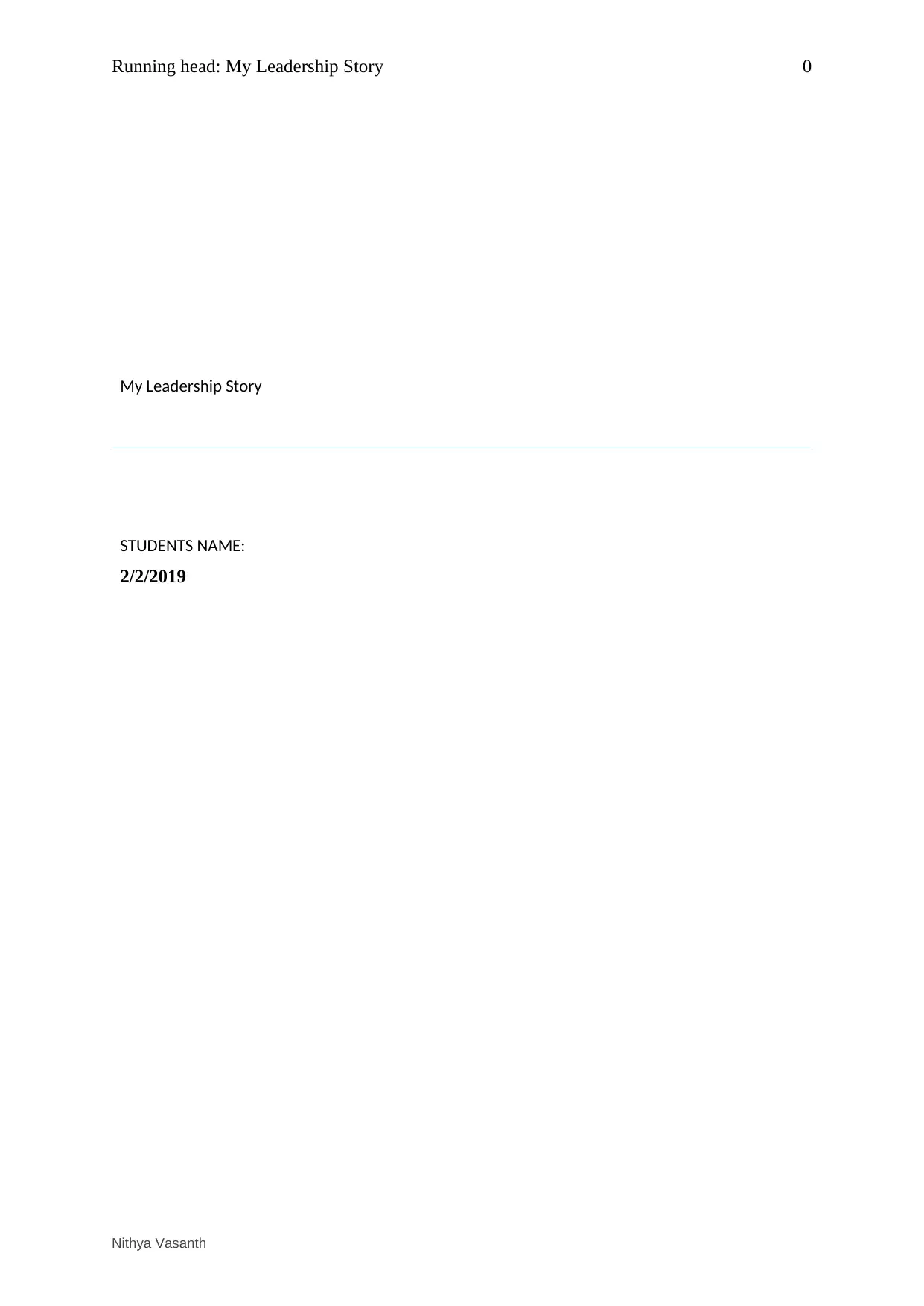
Running head: My Leadership Story 0
My Leadership Story
STUDENTS NAME:
2/2/2019
Nithya Vasanth
My Leadership Story
STUDENTS NAME:
2/2/2019
Nithya Vasanth
Paraphrase This Document
Need a fresh take? Get an instant paraphrase of this document with our AI Paraphraser
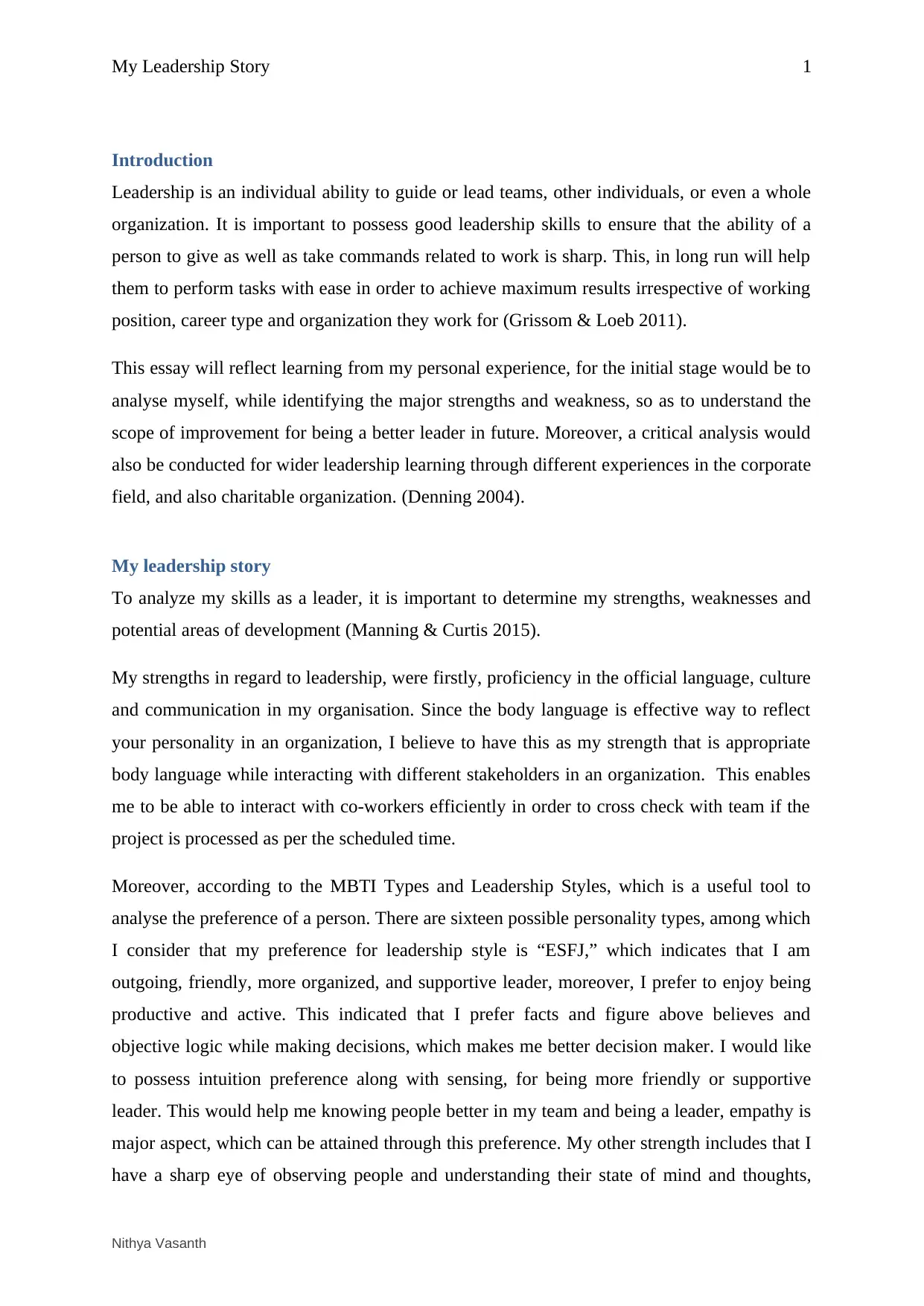
My Leadership Story 1
Introduction
Leadership is an individual ability to guide or lead teams, other individuals, or even a whole
organization. It is important to possess good leadership skills to ensure that the ability of a
person to give as well as take commands related to work is sharp. This, in long run will help
them to perform tasks with ease in order to achieve maximum results irrespective of working
position, career type and organization they work for (Grissom & Loeb 2011).
This essay will reflect learning from my personal experience, for the initial stage would be to
analyse myself, while identifying the major strengths and weakness, so as to understand the
scope of improvement for being a better leader in future. Moreover, a critical analysis would
also be conducted for wider leadership learning through different experiences in the corporate
field, and also charitable organization. (Denning 2004).
My leadership story
To analyze my skills as a leader, it is important to determine my strengths, weaknesses and
potential areas of development (Manning & Curtis 2015).
My strengths in regard to leadership, were firstly, proficiency in the official language, culture
and communication in my organisation. Since the body language is effective way to reflect
your personality in an organization, I believe to have this as my strength that is appropriate
body language while interacting with different stakeholders in an organization. This enables
me to be able to interact with co-workers efficiently in order to cross check with team if the
project is processed as per the scheduled time.
Moreover, according to the MBTI Types and Leadership Styles, which is a useful tool to
analyse the preference of a person. There are sixteen possible personality types, among which
I consider that my preference for leadership style is “ESFJ,” which indicates that I am
outgoing, friendly, more organized, and supportive leader, moreover, I prefer to enjoy being
productive and active. This indicated that I prefer facts and figure above believes and
objective logic while making decisions, which makes me better decision maker. I would like
to possess intuition preference along with sensing, for being more friendly or supportive
leader. This would help me knowing people better in my team and being a leader, empathy is
major aspect, which can be attained through this preference. My other strength includes that I
have a sharp eye of observing people and understanding their state of mind and thoughts,
Nithya Vasanth
Introduction
Leadership is an individual ability to guide or lead teams, other individuals, or even a whole
organization. It is important to possess good leadership skills to ensure that the ability of a
person to give as well as take commands related to work is sharp. This, in long run will help
them to perform tasks with ease in order to achieve maximum results irrespective of working
position, career type and organization they work for (Grissom & Loeb 2011).
This essay will reflect learning from my personal experience, for the initial stage would be to
analyse myself, while identifying the major strengths and weakness, so as to understand the
scope of improvement for being a better leader in future. Moreover, a critical analysis would
also be conducted for wider leadership learning through different experiences in the corporate
field, and also charitable organization. (Denning 2004).
My leadership story
To analyze my skills as a leader, it is important to determine my strengths, weaknesses and
potential areas of development (Manning & Curtis 2015).
My strengths in regard to leadership, were firstly, proficiency in the official language, culture
and communication in my organisation. Since the body language is effective way to reflect
your personality in an organization, I believe to have this as my strength that is appropriate
body language while interacting with different stakeholders in an organization. This enables
me to be able to interact with co-workers efficiently in order to cross check with team if the
project is processed as per the scheduled time.
Moreover, according to the MBTI Types and Leadership Styles, which is a useful tool to
analyse the preference of a person. There are sixteen possible personality types, among which
I consider that my preference for leadership style is “ESFJ,” which indicates that I am
outgoing, friendly, more organized, and supportive leader, moreover, I prefer to enjoy being
productive and active. This indicated that I prefer facts and figure above believes and
objective logic while making decisions, which makes me better decision maker. I would like
to possess intuition preference along with sensing, for being more friendly or supportive
leader. This would help me knowing people better in my team and being a leader, empathy is
major aspect, which can be attained through this preference. My other strength includes that I
have a sharp eye of observing people and understanding their state of mind and thoughts,
Nithya Vasanth
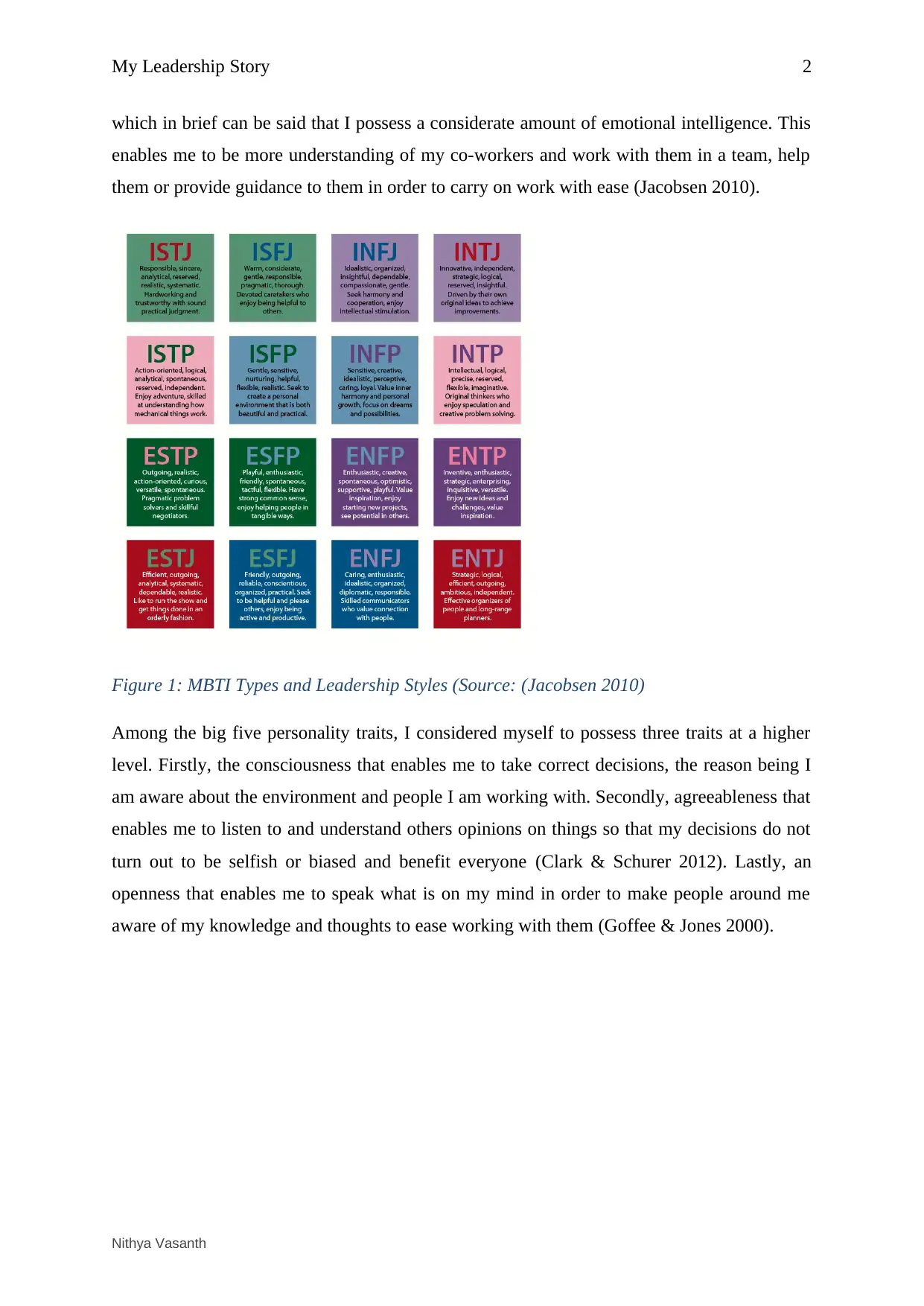
My Leadership Story 2
which in brief can be said that I possess a considerate amount of emotional intelligence. This
enables me to be more understanding of my co-workers and work with them in a team, help
them or provide guidance to them in order to carry on work with ease (Jacobsen 2010).
Figure 1: MBTI Types and Leadership Styles (Source: (Jacobsen 2010)
Among the big five personality traits, I considered myself to possess three traits at a higher
level. Firstly, the consciousness that enables me to take correct decisions, the reason being I
am aware about the environment and people I am working with. Secondly, agreeableness that
enables me to listen to and understand others opinions on things so that my decisions do not
turn out to be selfish or biased and benefit everyone (Clark & Schurer 2012). Lastly, an
openness that enables me to speak what is on my mind in order to make people around me
aware of my knowledge and thoughts to ease working with them (Goffee & Jones 2000).
Nithya Vasanth
which in brief can be said that I possess a considerate amount of emotional intelligence. This
enables me to be more understanding of my co-workers and work with them in a team, help
them or provide guidance to them in order to carry on work with ease (Jacobsen 2010).
Figure 1: MBTI Types and Leadership Styles (Source: (Jacobsen 2010)
Among the big five personality traits, I considered myself to possess three traits at a higher
level. Firstly, the consciousness that enables me to take correct decisions, the reason being I
am aware about the environment and people I am working with. Secondly, agreeableness that
enables me to listen to and understand others opinions on things so that my decisions do not
turn out to be selfish or biased and benefit everyone (Clark & Schurer 2012). Lastly, an
openness that enables me to speak what is on my mind in order to make people around me
aware of my knowledge and thoughts to ease working with them (Goffee & Jones 2000).
Nithya Vasanth
⊘ This is a preview!⊘
Do you want full access?
Subscribe today to unlock all pages.

Trusted by 1+ million students worldwide
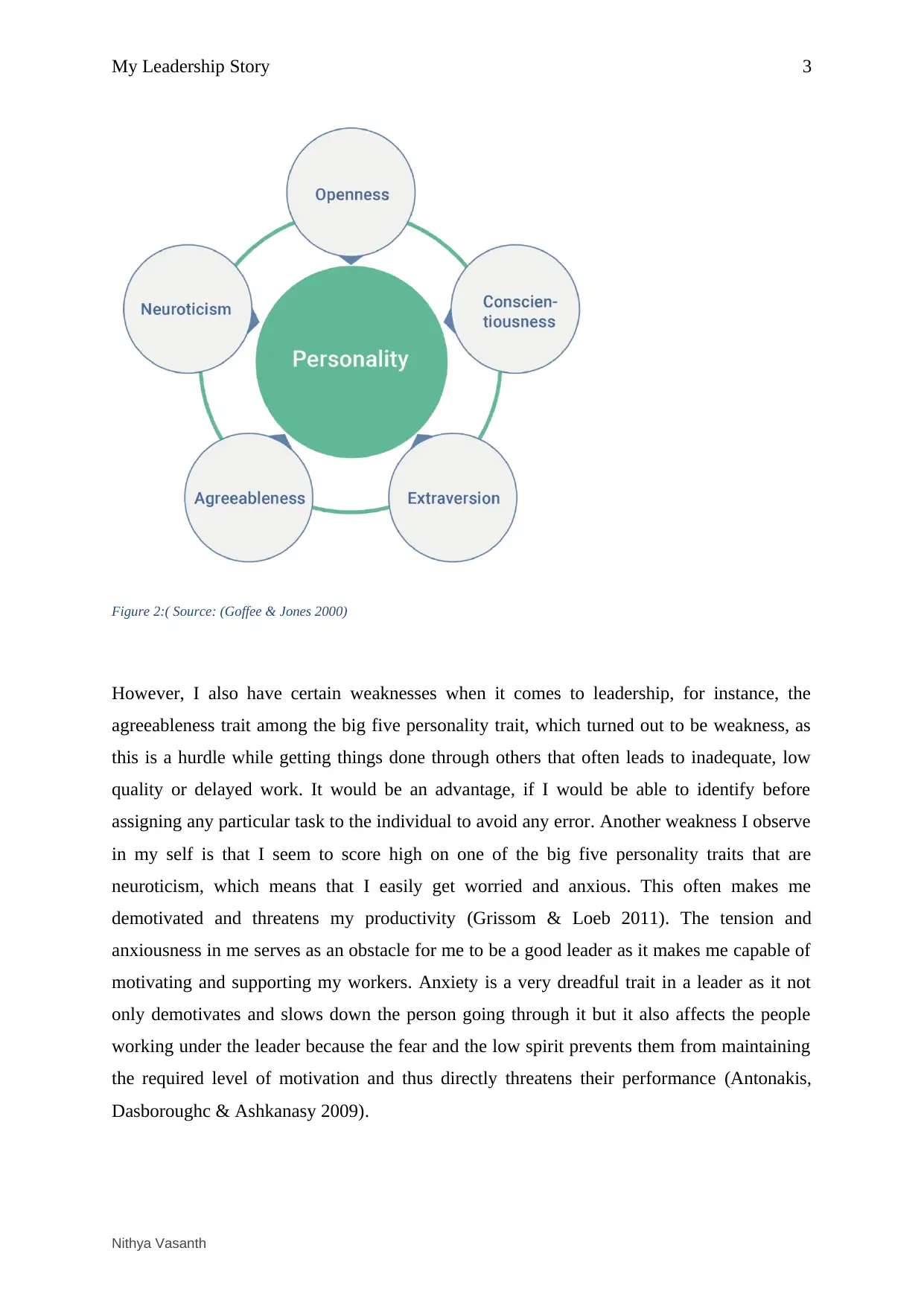
My Leadership Story 3
Figure 2:( Source: (Goffee & Jones 2000)
However, I also have certain weaknesses when it comes to leadership, for instance, the
agreeableness trait among the big five personality trait, which turned out to be weakness, as
this is a hurdle while getting things done through others that often leads to inadequate, low
quality or delayed work. It would be an advantage, if I would be able to identify before
assigning any particular task to the individual to avoid any error. Another weakness I observe
in my self is that I seem to score high on one of the big five personality traits that are
neuroticism, which means that I easily get worried and anxious. This often makes me
demotivated and threatens my productivity (Grissom & Loeb 2011). The tension and
anxiousness in me serves as an obstacle for me to be a good leader as it makes me capable of
motivating and supporting my workers. Anxiety is a very dreadful trait in a leader as it not
only demotivates and slows down the person going through it but it also affects the people
working under the leader because the fear and the low spirit prevents them from maintaining
the required level of motivation and thus directly threatens their performance (Antonakis,
Dasboroughc & Ashkanasy 2009).
Nithya Vasanth
Figure 2:( Source: (Goffee & Jones 2000)
However, I also have certain weaknesses when it comes to leadership, for instance, the
agreeableness trait among the big five personality trait, which turned out to be weakness, as
this is a hurdle while getting things done through others that often leads to inadequate, low
quality or delayed work. It would be an advantage, if I would be able to identify before
assigning any particular task to the individual to avoid any error. Another weakness I observe
in my self is that I seem to score high on one of the big five personality traits that are
neuroticism, which means that I easily get worried and anxious. This often makes me
demotivated and threatens my productivity (Grissom & Loeb 2011). The tension and
anxiousness in me serves as an obstacle for me to be a good leader as it makes me capable of
motivating and supporting my workers. Anxiety is a very dreadful trait in a leader as it not
only demotivates and slows down the person going through it but it also affects the people
working under the leader because the fear and the low spirit prevents them from maintaining
the required level of motivation and thus directly threatens their performance (Antonakis,
Dasboroughc & Ashkanasy 2009).
Nithya Vasanth
Paraphrase This Document
Need a fresh take? Get an instant paraphrase of this document with our AI Paraphraser
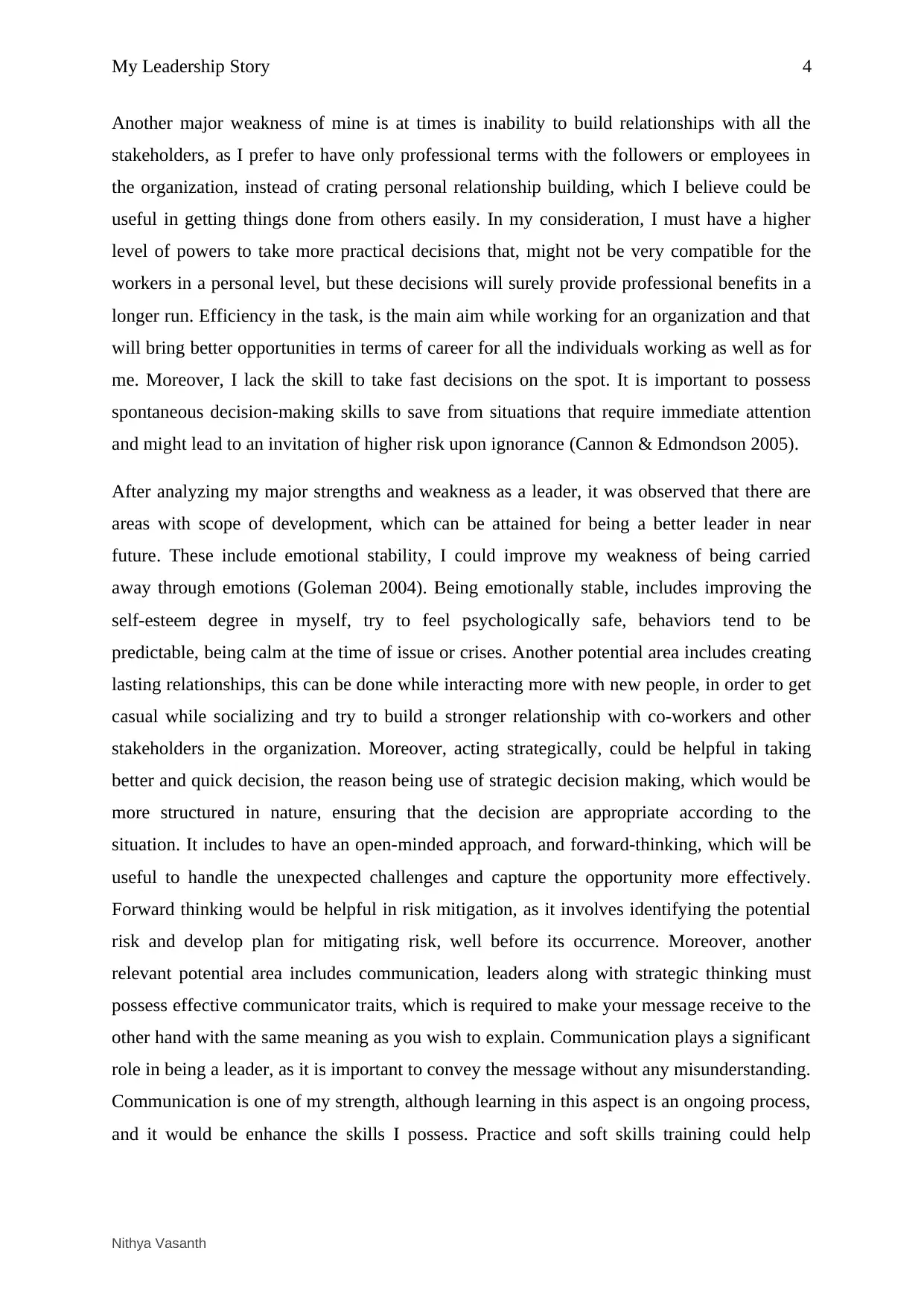
My Leadership Story 4
Another major weakness of mine is at times is inability to build relationships with all the
stakeholders, as I prefer to have only professional terms with the followers or employees in
the organization, instead of crating personal relationship building, which I believe could be
useful in getting things done from others easily. In my consideration, I must have a higher
level of powers to take more practical decisions that, might not be very compatible for the
workers in a personal level, but these decisions will surely provide professional benefits in a
longer run. Efficiency in the task, is the main aim while working for an organization and that
will bring better opportunities in terms of career for all the individuals working as well as for
me. Moreover, I lack the skill to take fast decisions on the spot. It is important to possess
spontaneous decision-making skills to save from situations that require immediate attention
and might lead to an invitation of higher risk upon ignorance (Cannon & Edmondson 2005).
After analyzing my major strengths and weakness as a leader, it was observed that there are
areas with scope of development, which can be attained for being a better leader in near
future. These include emotional stability, I could improve my weakness of being carried
away through emotions (Goleman 2004). Being emotionally stable, includes improving the
self-esteem degree in myself, try to feel psychologically safe, behaviors tend to be
predictable, being calm at the time of issue or crises. Another potential area includes creating
lasting relationships, this can be done while interacting more with new people, in order to get
casual while socializing and try to build a stronger relationship with co-workers and other
stakeholders in the organization. Moreover, acting strategically, could be helpful in taking
better and quick decision, the reason being use of strategic decision making, which would be
more structured in nature, ensuring that the decision are appropriate according to the
situation. It includes to have an open-minded approach, and forward-thinking, which will be
useful to handle the unexpected challenges and capture the opportunity more effectively.
Forward thinking would be helpful in risk mitigation, as it involves identifying the potential
risk and develop plan for mitigating risk, well before its occurrence. Moreover, another
relevant potential area includes communication, leaders along with strategic thinking must
possess effective communicator traits, which is required to make your message receive to the
other hand with the same meaning as you wish to explain. Communication plays a significant
role in being a leader, as it is important to convey the message without any misunderstanding.
Communication is one of my strength, although learning in this aspect is an ongoing process,
and it would be enhance the skills I possess. Practice and soft skills training could help
Nithya Vasanth
Another major weakness of mine is at times is inability to build relationships with all the
stakeholders, as I prefer to have only professional terms with the followers or employees in
the organization, instead of crating personal relationship building, which I believe could be
useful in getting things done from others easily. In my consideration, I must have a higher
level of powers to take more practical decisions that, might not be very compatible for the
workers in a personal level, but these decisions will surely provide professional benefits in a
longer run. Efficiency in the task, is the main aim while working for an organization and that
will bring better opportunities in terms of career for all the individuals working as well as for
me. Moreover, I lack the skill to take fast decisions on the spot. It is important to possess
spontaneous decision-making skills to save from situations that require immediate attention
and might lead to an invitation of higher risk upon ignorance (Cannon & Edmondson 2005).
After analyzing my major strengths and weakness as a leader, it was observed that there are
areas with scope of development, which can be attained for being a better leader in near
future. These include emotional stability, I could improve my weakness of being carried
away through emotions (Goleman 2004). Being emotionally stable, includes improving the
self-esteem degree in myself, try to feel psychologically safe, behaviors tend to be
predictable, being calm at the time of issue or crises. Another potential area includes creating
lasting relationships, this can be done while interacting more with new people, in order to get
casual while socializing and try to build a stronger relationship with co-workers and other
stakeholders in the organization. Moreover, acting strategically, could be helpful in taking
better and quick decision, the reason being use of strategic decision making, which would be
more structured in nature, ensuring that the decision are appropriate according to the
situation. It includes to have an open-minded approach, and forward-thinking, which will be
useful to handle the unexpected challenges and capture the opportunity more effectively.
Forward thinking would be helpful in risk mitigation, as it involves identifying the potential
risk and develop plan for mitigating risk, well before its occurrence. Moreover, another
relevant potential area includes communication, leaders along with strategic thinking must
possess effective communicator traits, which is required to make your message receive to the
other hand with the same meaning as you wish to explain. Communication plays a significant
role in being a leader, as it is important to convey the message without any misunderstanding.
Communication is one of my strength, although learning in this aspect is an ongoing process,
and it would be enhance the skills I possess. Practice and soft skills training could help
Nithya Vasanth
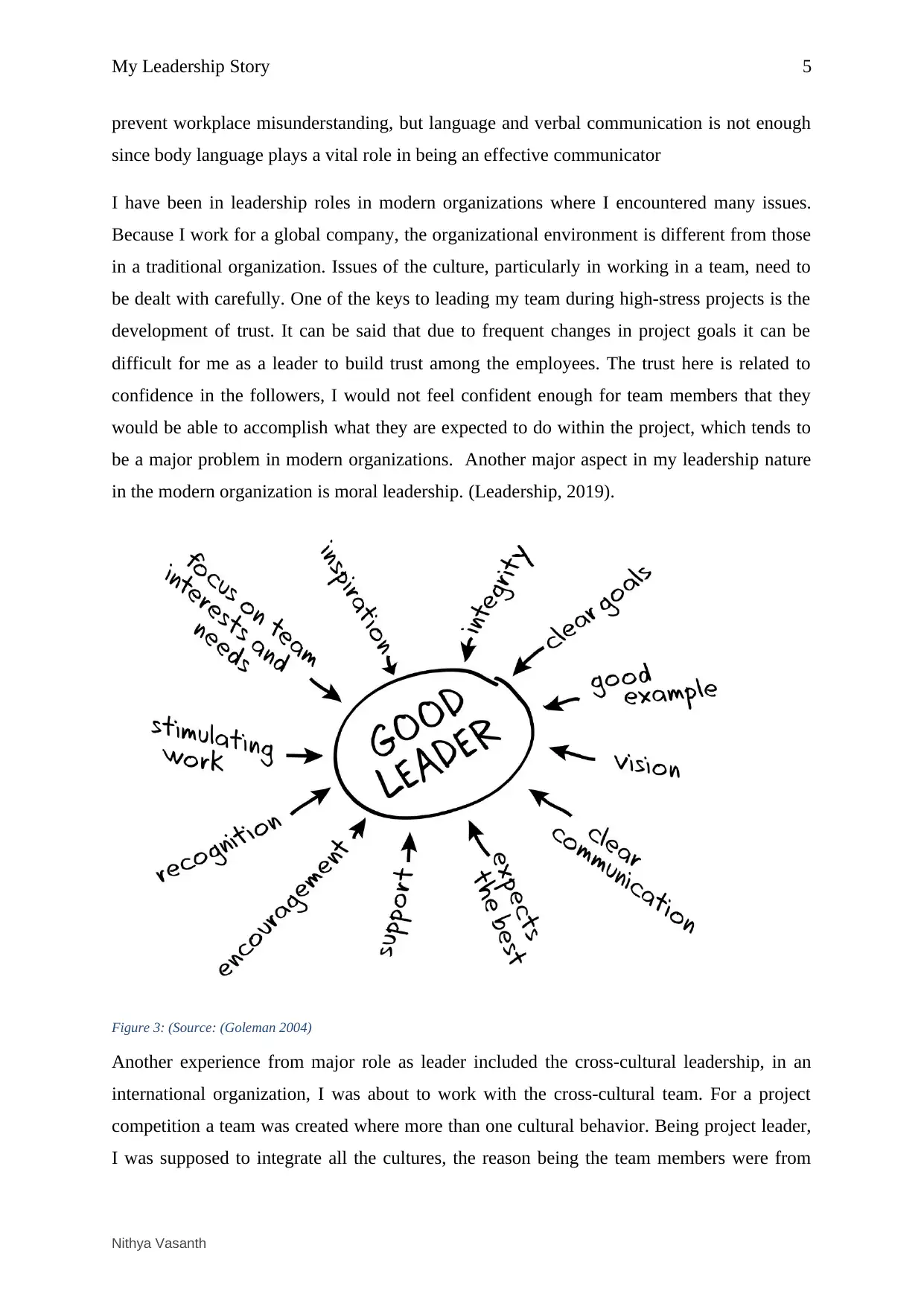
My Leadership Story 5
prevent workplace misunderstanding, but language and verbal communication is not enough
since body language plays a vital role in being an effective communicator
I have been in leadership roles in modern organizations where I encountered many issues.
Because I work for a global company, the organizational environment is different from those
in a traditional organization. Issues of the culture, particularly in working in a team, need to
be dealt with carefully. One of the keys to leading my team during high-stress projects is the
development of trust. It can be said that due to frequent changes in project goals it can be
difficult for me as a leader to build trust among the employees. The trust here is related to
confidence in the followers, I would not feel confident enough for team members that they
would be able to accomplish what they are expected to do within the project, which tends to
be a major problem in modern organizations. Another major aspect in my leadership nature
in the modern organization is moral leadership. (Leadership, 2019).
Figure 3: (Source: (Goleman 2004)
Another experience from major role as leader included the cross-cultural leadership, in an
international organization, I was about to work with the cross-cultural team. For a project
competition a team was created where more than one cultural behavior. Being project leader,
I was supposed to integrate all the cultures, the reason being the team members were from
Nithya Vasanth
prevent workplace misunderstanding, but language and verbal communication is not enough
since body language plays a vital role in being an effective communicator
I have been in leadership roles in modern organizations where I encountered many issues.
Because I work for a global company, the organizational environment is different from those
in a traditional organization. Issues of the culture, particularly in working in a team, need to
be dealt with carefully. One of the keys to leading my team during high-stress projects is the
development of trust. It can be said that due to frequent changes in project goals it can be
difficult for me as a leader to build trust among the employees. The trust here is related to
confidence in the followers, I would not feel confident enough for team members that they
would be able to accomplish what they are expected to do within the project, which tends to
be a major problem in modern organizations. Another major aspect in my leadership nature
in the modern organization is moral leadership. (Leadership, 2019).
Figure 3: (Source: (Goleman 2004)
Another experience from major role as leader included the cross-cultural leadership, in an
international organization, I was about to work with the cross-cultural team. For a project
competition a team was created where more than one cultural behavior. Being project leader,
I was supposed to integrate all the cultures, the reason being the team members were from
Nithya Vasanth
⊘ This is a preview!⊘
Do you want full access?
Subscribe today to unlock all pages.

Trusted by 1+ million students worldwide
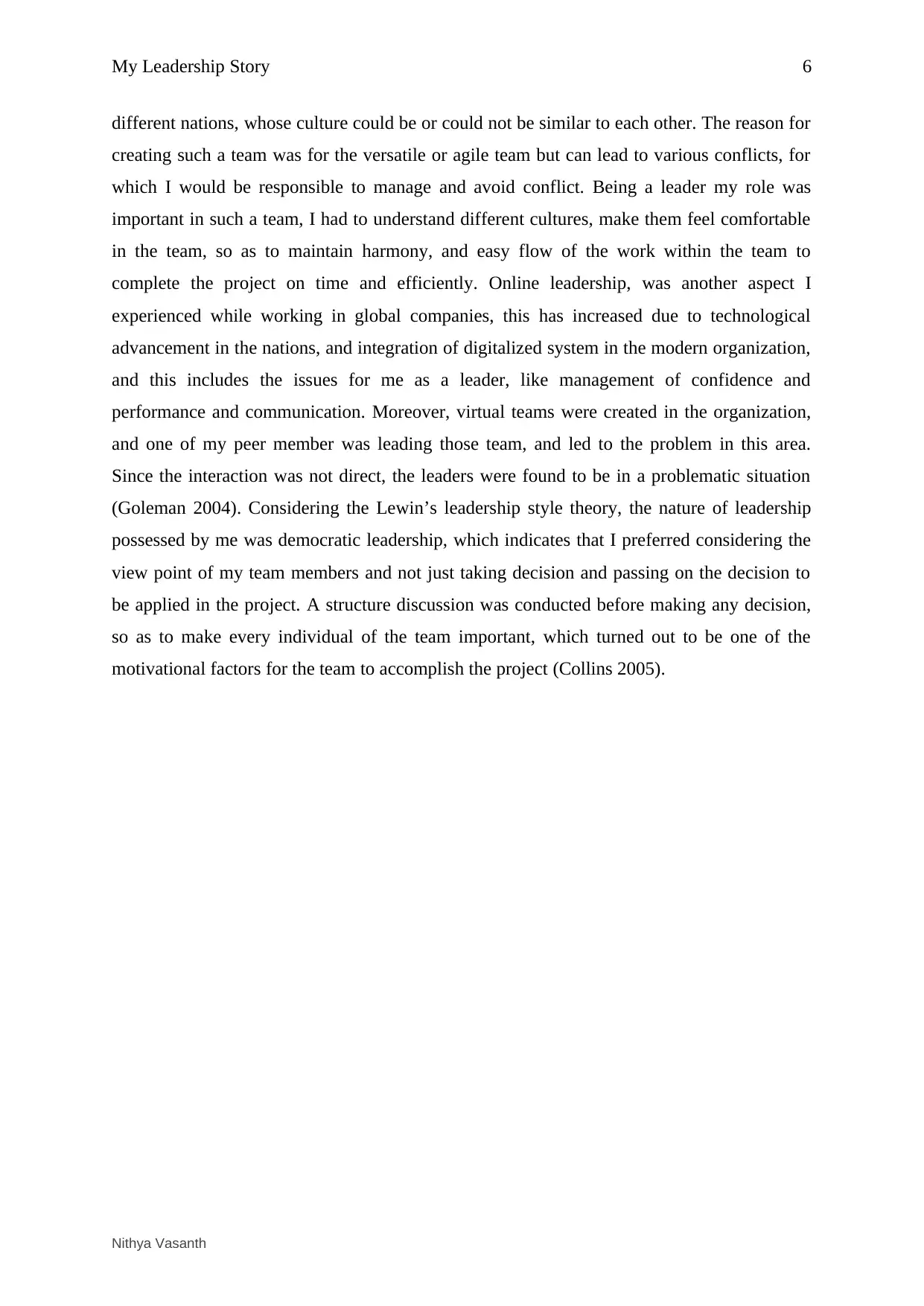
My Leadership Story 6
different nations, whose culture could be or could not be similar to each other. The reason for
creating such a team was for the versatile or agile team but can lead to various conflicts, for
which I would be responsible to manage and avoid conflict. Being a leader my role was
important in such a team, I had to understand different cultures, make them feel comfortable
in the team, so as to maintain harmony, and easy flow of the work within the team to
complete the project on time and efficiently. Online leadership, was another aspect I
experienced while working in global companies, this has increased due to technological
advancement in the nations, and integration of digitalized system in the modern organization,
and this includes the issues for me as a leader, like management of confidence and
performance and communication. Moreover, virtual teams were created in the organization,
and one of my peer member was leading those team, and led to the problem in this area.
Since the interaction was not direct, the leaders were found to be in a problematic situation
(Goleman 2004). Considering the Lewin’s leadership style theory, the nature of leadership
possessed by me was democratic leadership, which indicates that I preferred considering the
view point of my team members and not just taking decision and passing on the decision to
be applied in the project. A structure discussion was conducted before making any decision,
so as to make every individual of the team important, which turned out to be one of the
motivational factors for the team to accomplish the project (Collins 2005).
Nithya Vasanth
different nations, whose culture could be or could not be similar to each other. The reason for
creating such a team was for the versatile or agile team but can lead to various conflicts, for
which I would be responsible to manage and avoid conflict. Being a leader my role was
important in such a team, I had to understand different cultures, make them feel comfortable
in the team, so as to maintain harmony, and easy flow of the work within the team to
complete the project on time and efficiently. Online leadership, was another aspect I
experienced while working in global companies, this has increased due to technological
advancement in the nations, and integration of digitalized system in the modern organization,
and this includes the issues for me as a leader, like management of confidence and
performance and communication. Moreover, virtual teams were created in the organization,
and one of my peer member was leading those team, and led to the problem in this area.
Since the interaction was not direct, the leaders were found to be in a problematic situation
(Goleman 2004). Considering the Lewin’s leadership style theory, the nature of leadership
possessed by me was democratic leadership, which indicates that I preferred considering the
view point of my team members and not just taking decision and passing on the decision to
be applied in the project. A structure discussion was conducted before making any decision,
so as to make every individual of the team important, which turned out to be one of the
motivational factors for the team to accomplish the project (Collins 2005).
Nithya Vasanth
Paraphrase This Document
Need a fresh take? Get an instant paraphrase of this document with our AI Paraphraser
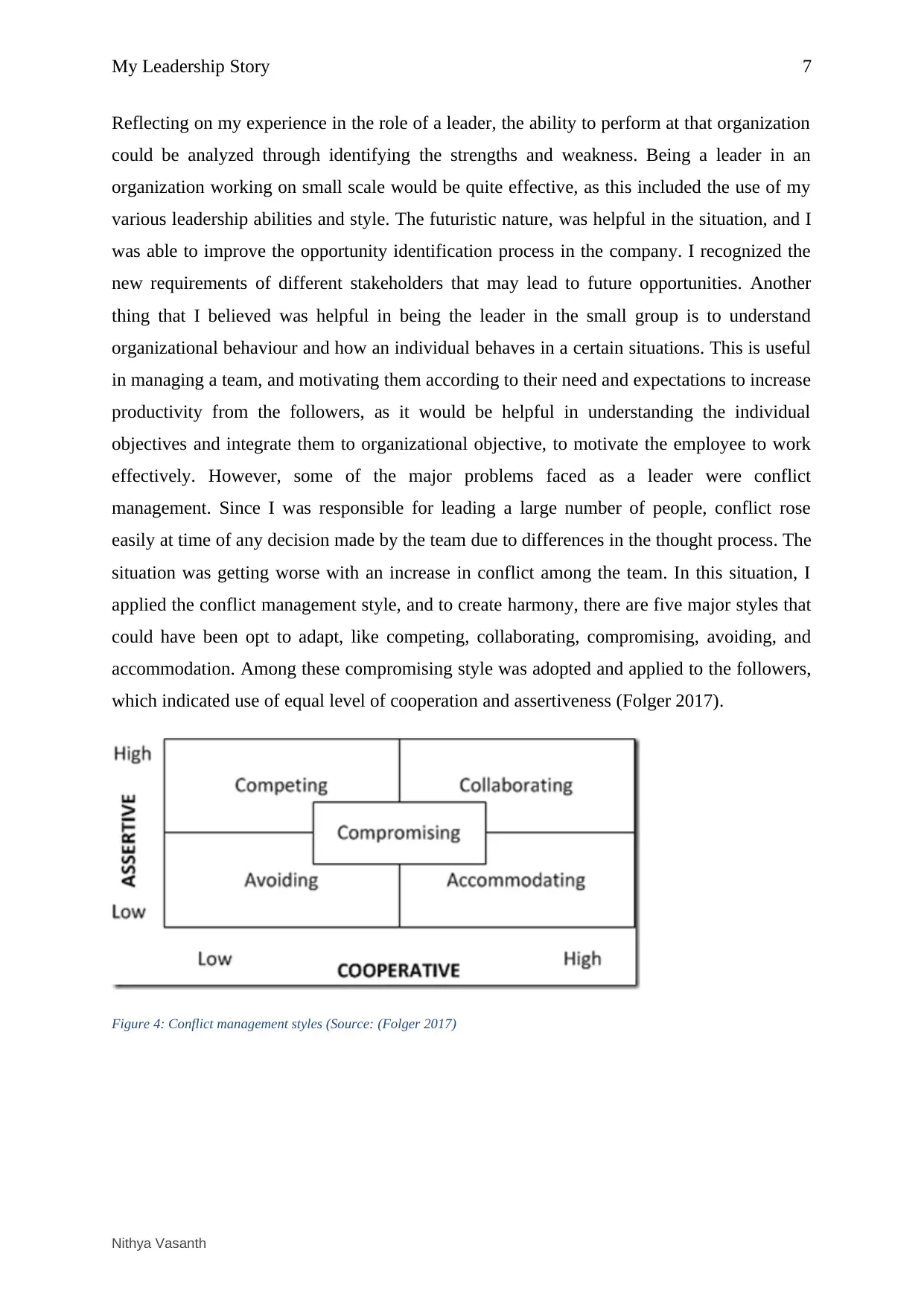
My Leadership Story 7
Reflecting on my experience in the role of a leader, the ability to perform at that organization
could be analyzed through identifying the strengths and weakness. Being a leader in an
organization working on small scale would be quite effective, as this included the use of my
various leadership abilities and style. The futuristic nature, was helpful in the situation, and I
was able to improve the opportunity identification process in the company. I recognized the
new requirements of different stakeholders that may lead to future opportunities. Another
thing that I believed was helpful in being the leader in the small group is to understand
organizational behaviour and how an individual behaves in a certain situations. This is useful
in managing a team, and motivating them according to their need and expectations to increase
productivity from the followers, as it would be helpful in understanding the individual
objectives and integrate them to organizational objective, to motivate the employee to work
effectively. However, some of the major problems faced as a leader were conflict
management. Since I was responsible for leading a large number of people, conflict rose
easily at time of any decision made by the team due to differences in the thought process. The
situation was getting worse with an increase in conflict among the team. In this situation, I
applied the conflict management style, and to create harmony, there are five major styles that
could have been opt to adapt, like competing, collaborating, compromising, avoiding, and
accommodation. Among these compromising style was adopted and applied to the followers,
which indicated use of equal level of cooperation and assertiveness (Folger 2017).
Figure 4: Conflict management styles (Source: (Folger 2017)
Nithya Vasanth
Reflecting on my experience in the role of a leader, the ability to perform at that organization
could be analyzed through identifying the strengths and weakness. Being a leader in an
organization working on small scale would be quite effective, as this included the use of my
various leadership abilities and style. The futuristic nature, was helpful in the situation, and I
was able to improve the opportunity identification process in the company. I recognized the
new requirements of different stakeholders that may lead to future opportunities. Another
thing that I believed was helpful in being the leader in the small group is to understand
organizational behaviour and how an individual behaves in a certain situations. This is useful
in managing a team, and motivating them according to their need and expectations to increase
productivity from the followers, as it would be helpful in understanding the individual
objectives and integrate them to organizational objective, to motivate the employee to work
effectively. However, some of the major problems faced as a leader were conflict
management. Since I was responsible for leading a large number of people, conflict rose
easily at time of any decision made by the team due to differences in the thought process. The
situation was getting worse with an increase in conflict among the team. In this situation, I
applied the conflict management style, and to create harmony, there are five major styles that
could have been opt to adapt, like competing, collaborating, compromising, avoiding, and
accommodation. Among these compromising style was adopted and applied to the followers,
which indicated use of equal level of cooperation and assertiveness (Folger 2017).
Figure 4: Conflict management styles (Source: (Folger 2017)
Nithya Vasanth
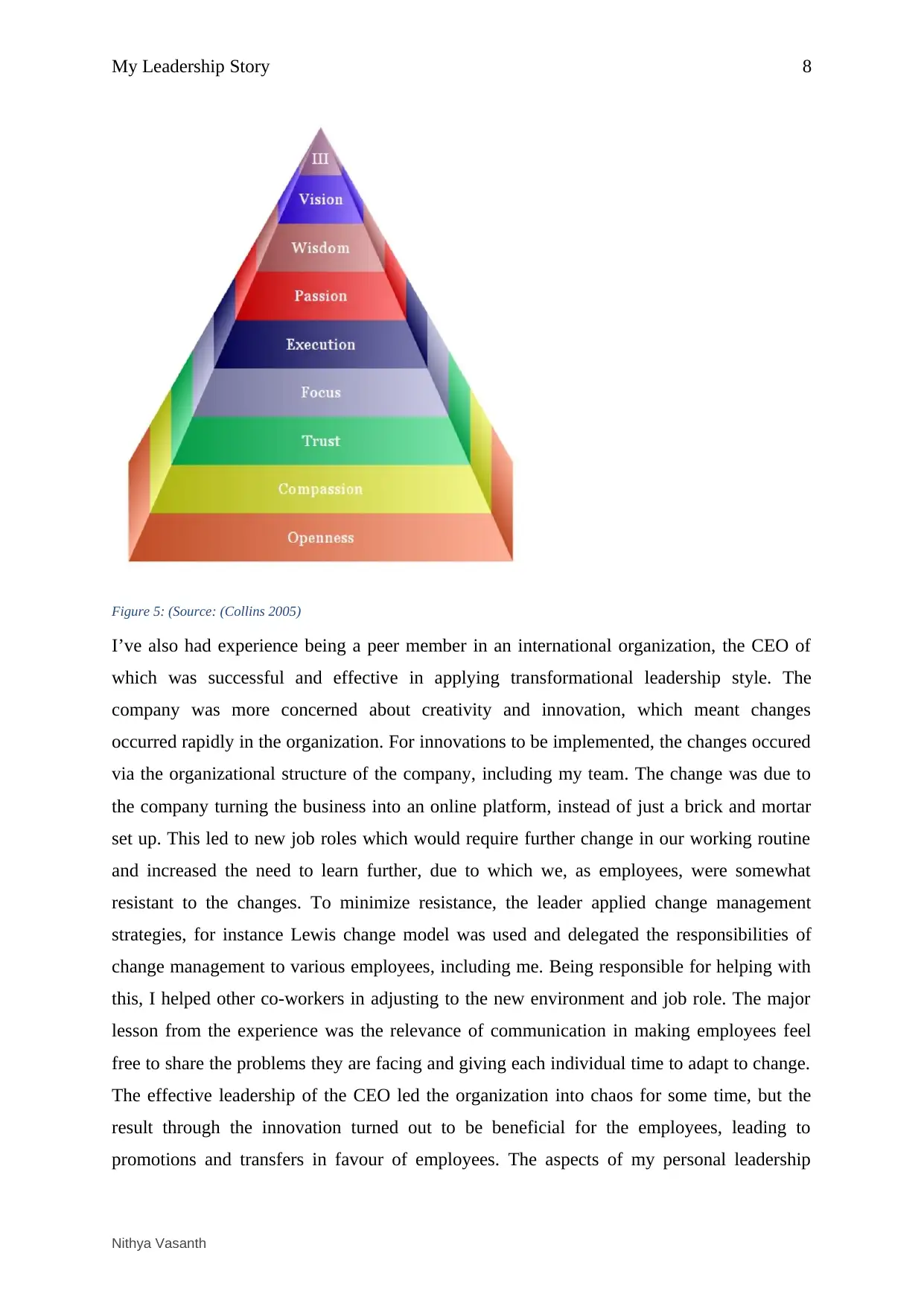
My Leadership Story 8
Figure 5: (Source: (Collins 2005)
I’ve also had experience being a peer member in an international organization, the CEO of
which was successful and effective in applying transformational leadership style. The
company was more concerned about creativity and innovation, which meant changes
occurred rapidly in the organization. For innovations to be implemented, the changes occured
via the organizational structure of the company, including my team. The change was due to
the company turning the business into an online platform, instead of just a brick and mortar
set up. This led to new job roles which would require further change in our working routine
and increased the need to learn further, due to which we, as employees, were somewhat
resistant to the changes. To minimize resistance, the leader applied change management
strategies, for instance Lewis change model was used and delegated the responsibilities of
change management to various employees, including me. Being responsible for helping with
this, I helped other co-workers in adjusting to the new environment and job role. The major
lesson from the experience was the relevance of communication in making employees feel
free to share the problems they are facing and giving each individual time to adapt to change.
The effective leadership of the CEO led the organization into chaos for some time, but the
result through the innovation turned out to be beneficial for the employees, leading to
promotions and transfers in favour of employees. The aspects of my personal leadership
Nithya Vasanth
Figure 5: (Source: (Collins 2005)
I’ve also had experience being a peer member in an international organization, the CEO of
which was successful and effective in applying transformational leadership style. The
company was more concerned about creativity and innovation, which meant changes
occurred rapidly in the organization. For innovations to be implemented, the changes occured
via the organizational structure of the company, including my team. The change was due to
the company turning the business into an online platform, instead of just a brick and mortar
set up. This led to new job roles which would require further change in our working routine
and increased the need to learn further, due to which we, as employees, were somewhat
resistant to the changes. To minimize resistance, the leader applied change management
strategies, for instance Lewis change model was used and delegated the responsibilities of
change management to various employees, including me. Being responsible for helping with
this, I helped other co-workers in adjusting to the new environment and job role. The major
lesson from the experience was the relevance of communication in making employees feel
free to share the problems they are facing and giving each individual time to adapt to change.
The effective leadership of the CEO led the organization into chaos for some time, but the
result through the innovation turned out to be beneficial for the employees, leading to
promotions and transfers in favour of employees. The aspects of my personal leadership
Nithya Vasanth
⊘ This is a preview!⊘
Do you want full access?
Subscribe today to unlock all pages.

Trusted by 1+ million students worldwide
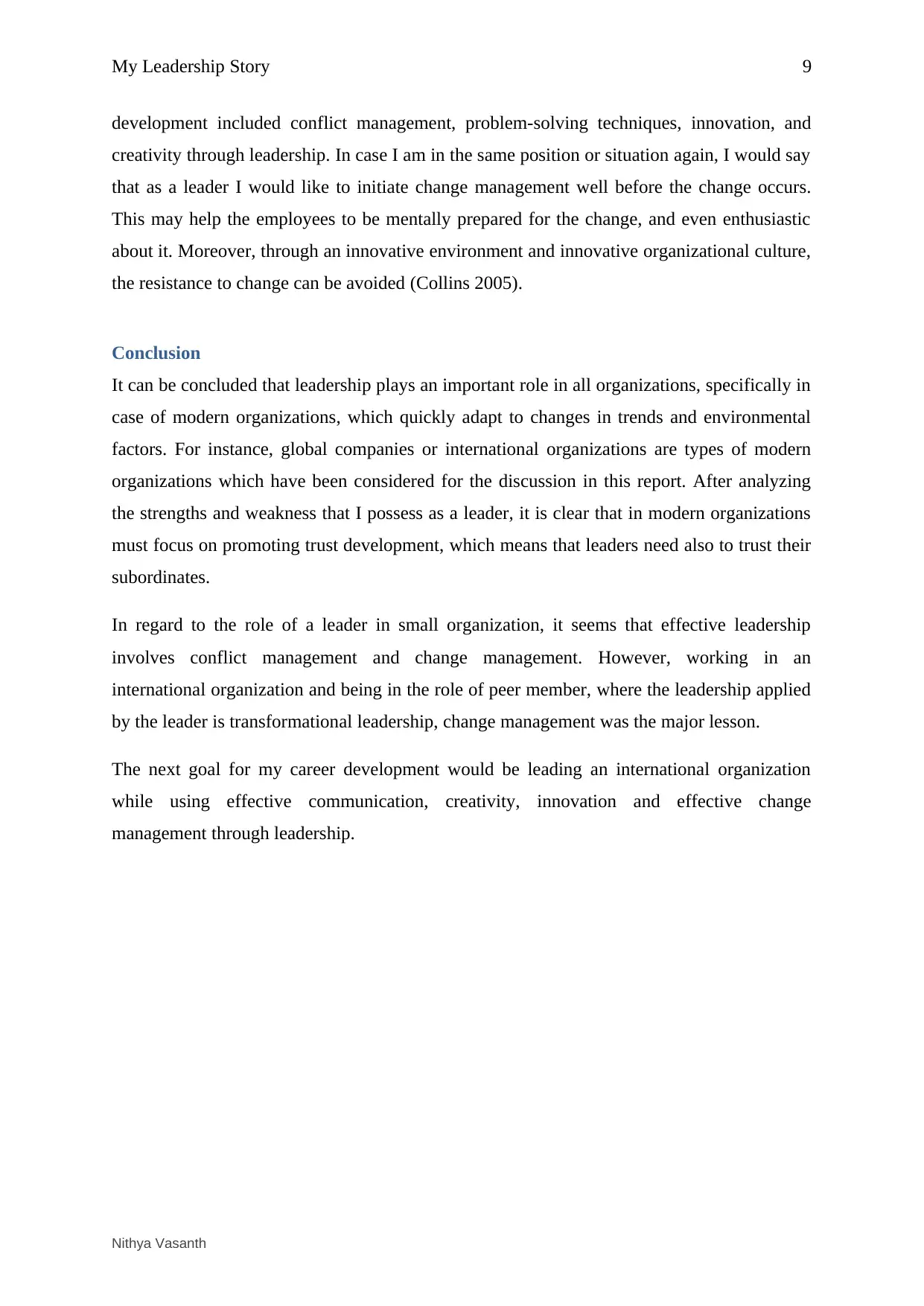
My Leadership Story 9
development included conflict management, problem-solving techniques, innovation, and
creativity through leadership. In case I am in the same position or situation again, I would say
that as a leader I would like to initiate change management well before the change occurs.
This may help the employees to be mentally prepared for the change, and even enthusiastic
about it. Moreover, through an innovative environment and innovative organizational culture,
the resistance to change can be avoided (Collins 2005).
Conclusion
It can be concluded that leadership plays an important role in all organizations, specifically in
case of modern organizations, which quickly adapt to changes in trends and environmental
factors. For instance, global companies or international organizations are types of modern
organizations which have been considered for the discussion in this report. After analyzing
the strengths and weakness that I possess as a leader, it is clear that in modern organizations
must focus on promoting trust development, which means that leaders need also to trust their
subordinates.
In regard to the role of a leader in small organization, it seems that effective leadership
involves conflict management and change management. However, working in an
international organization and being in the role of peer member, where the leadership applied
by the leader is transformational leadership, change management was the major lesson.
The next goal for my career development would be leading an international organization
while using effective communication, creativity, innovation and effective change
management through leadership.
Nithya Vasanth
development included conflict management, problem-solving techniques, innovation, and
creativity through leadership. In case I am in the same position or situation again, I would say
that as a leader I would like to initiate change management well before the change occurs.
This may help the employees to be mentally prepared for the change, and even enthusiastic
about it. Moreover, through an innovative environment and innovative organizational culture,
the resistance to change can be avoided (Collins 2005).
Conclusion
It can be concluded that leadership plays an important role in all organizations, specifically in
case of modern organizations, which quickly adapt to changes in trends and environmental
factors. For instance, global companies or international organizations are types of modern
organizations which have been considered for the discussion in this report. After analyzing
the strengths and weakness that I possess as a leader, it is clear that in modern organizations
must focus on promoting trust development, which means that leaders need also to trust their
subordinates.
In regard to the role of a leader in small organization, it seems that effective leadership
involves conflict management and change management. However, working in an
international organization and being in the role of peer member, where the leadership applied
by the leader is transformational leadership, change management was the major lesson.
The next goal for my career development would be leading an international organization
while using effective communication, creativity, innovation and effective change
management through leadership.
Nithya Vasanth
Paraphrase This Document
Need a fresh take? Get an instant paraphrase of this document with our AI Paraphraser
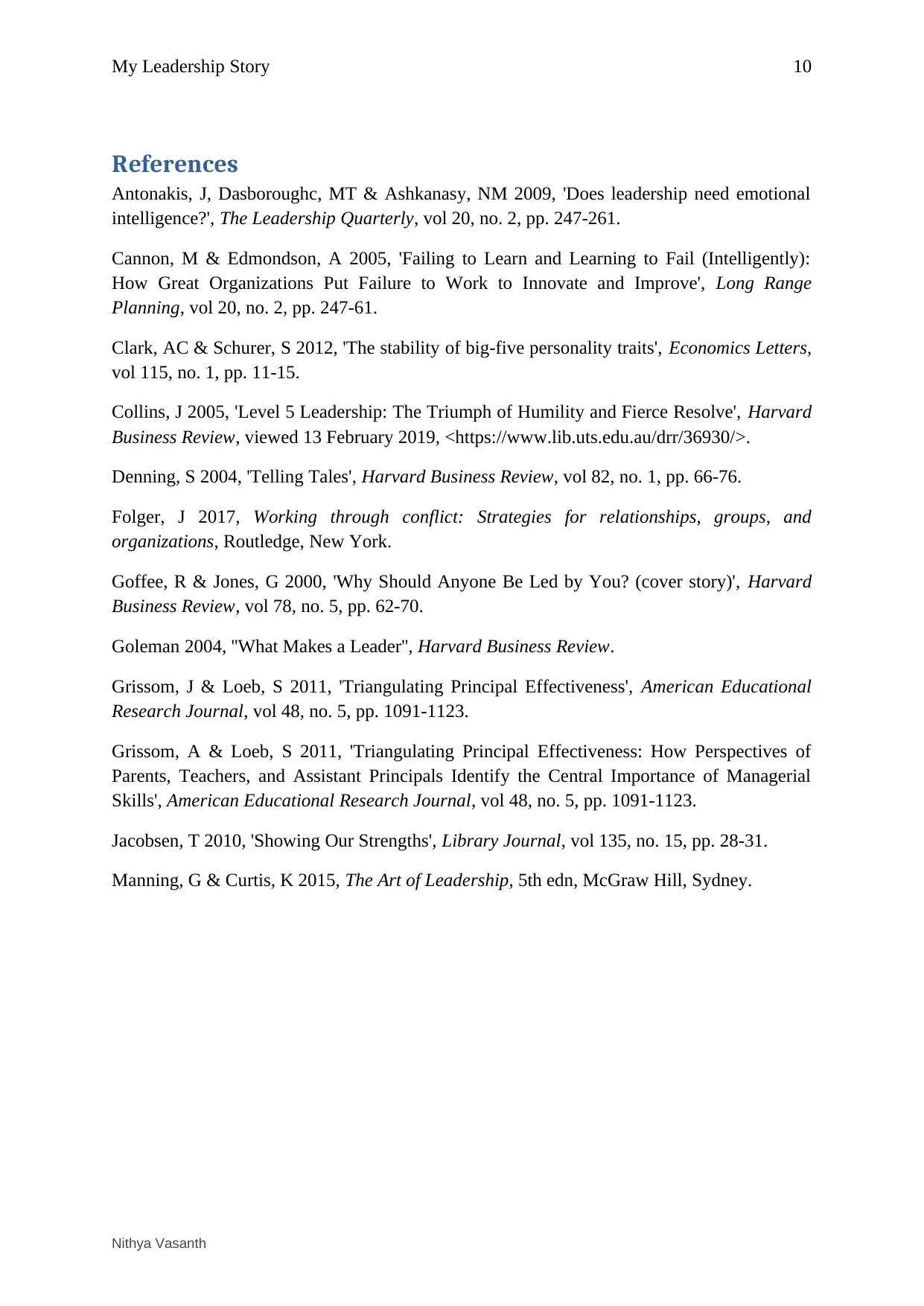
My Leadership Story 10
References
Antonakis, J, Dasboroughc, MT & Ashkanasy, NM 2009, 'Does leadership need emotional
intelligence?', The Leadership Quarterly, vol 20, no. 2, pp. 247-261.
Cannon, M & Edmondson, A 2005, 'Failing to Learn and Learning to Fail (Intelligently):
How Great Organizations Put Failure to Work to Innovate and Improve', Long Range
Planning, vol 20, no. 2, pp. 247-61.
Clark, AC & Schurer, S 2012, 'The stability of big-five personality traits', Economics Letters,
vol 115, no. 1, pp. 11-15.
Collins, J 2005, 'Level 5 Leadership: The Triumph of Humility and Fierce Resolve', Harvard
Business Review, viewed 13 February 2019, <https://www.lib.uts.edu.au/drr/36930/>.
Denning, S 2004, 'Telling Tales', Harvard Business Review, vol 82, no. 1, pp. 66-76.
Folger, J 2017, Working through conflict: Strategies for relationships, groups, and
organizations, Routledge, New York.
Goffee, R & Jones, G 2000, 'Why Should Anyone Be Led by You? (cover story)', Harvard
Business Review, vol 78, no. 5, pp. 62-70.
Goleman 2004, ''What Makes a Leader'', Harvard Business Review.
Grissom, J & Loeb, S 2011, 'Triangulating Principal Effectiveness', American Educational
Research Journal, vol 48, no. 5, pp. 1091-1123.
Grissom, A & Loeb, S 2011, 'Triangulating Principal Effectiveness: How Perspectives of
Parents, Teachers, and Assistant Principals Identify the Central Importance of Managerial
Skills', American Educational Research Journal, vol 48, no. 5, pp. 1091-1123.
Jacobsen, T 2010, 'Showing Our Strengths', Library Journal, vol 135, no. 15, pp. 28-31.
Manning, G & Curtis, K 2015, The Art of Leadership, 5th edn, McGraw Hill, Sydney.
Nithya Vasanth
References
Antonakis, J, Dasboroughc, MT & Ashkanasy, NM 2009, 'Does leadership need emotional
intelligence?', The Leadership Quarterly, vol 20, no. 2, pp. 247-261.
Cannon, M & Edmondson, A 2005, 'Failing to Learn and Learning to Fail (Intelligently):
How Great Organizations Put Failure to Work to Innovate and Improve', Long Range
Planning, vol 20, no. 2, pp. 247-61.
Clark, AC & Schurer, S 2012, 'The stability of big-five personality traits', Economics Letters,
vol 115, no. 1, pp. 11-15.
Collins, J 2005, 'Level 5 Leadership: The Triumph of Humility and Fierce Resolve', Harvard
Business Review, viewed 13 February 2019, <https://www.lib.uts.edu.au/drr/36930/>.
Denning, S 2004, 'Telling Tales', Harvard Business Review, vol 82, no. 1, pp. 66-76.
Folger, J 2017, Working through conflict: Strategies for relationships, groups, and
organizations, Routledge, New York.
Goffee, R & Jones, G 2000, 'Why Should Anyone Be Led by You? (cover story)', Harvard
Business Review, vol 78, no. 5, pp. 62-70.
Goleman 2004, ''What Makes a Leader'', Harvard Business Review.
Grissom, J & Loeb, S 2011, 'Triangulating Principal Effectiveness', American Educational
Research Journal, vol 48, no. 5, pp. 1091-1123.
Grissom, A & Loeb, S 2011, 'Triangulating Principal Effectiveness: How Perspectives of
Parents, Teachers, and Assistant Principals Identify the Central Importance of Managerial
Skills', American Educational Research Journal, vol 48, no. 5, pp. 1091-1123.
Jacobsen, T 2010, 'Showing Our Strengths', Library Journal, vol 135, no. 15, pp. 28-31.
Manning, G & Curtis, K 2015, The Art of Leadership, 5th edn, McGraw Hill, Sydney.
Nithya Vasanth
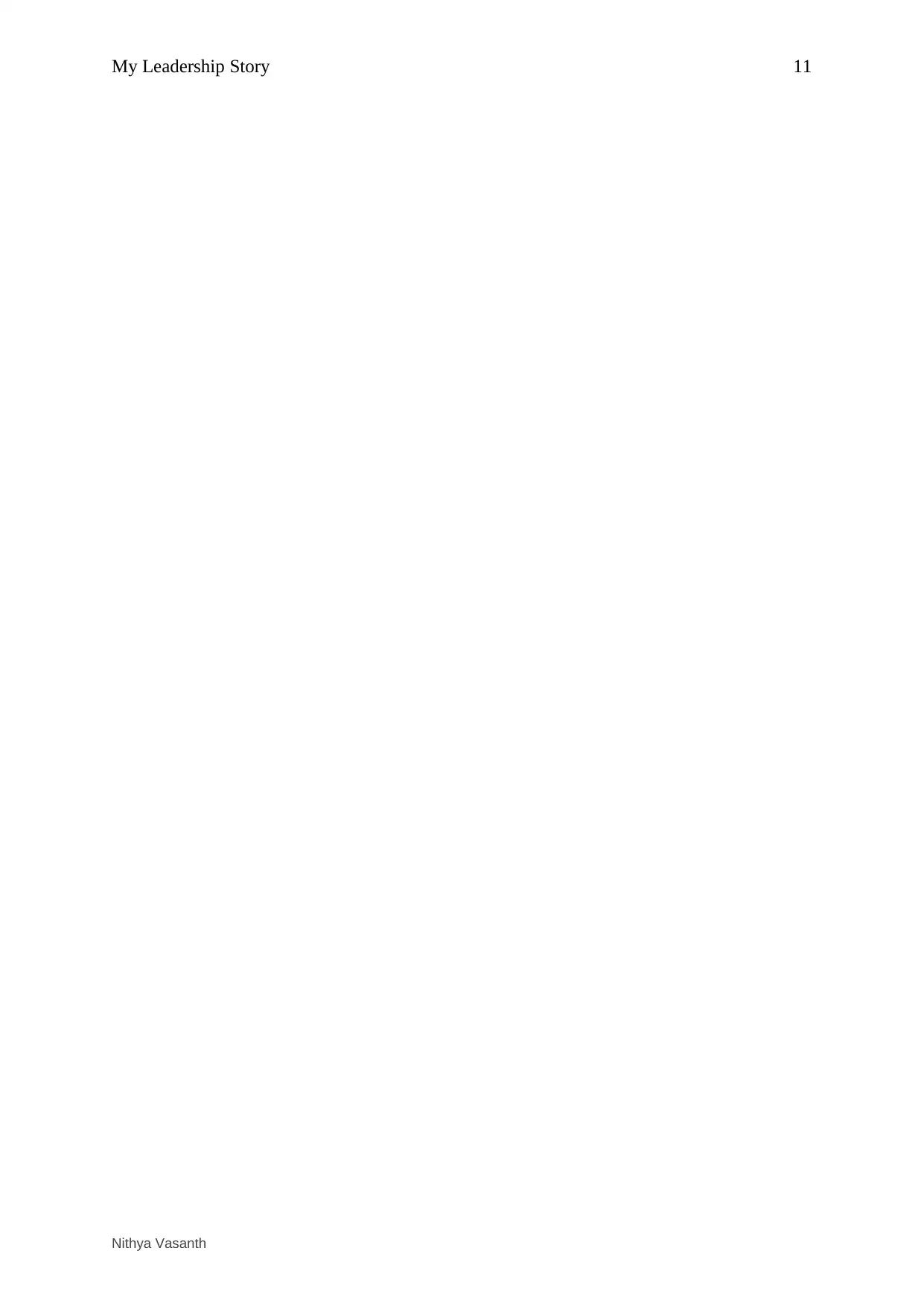
My Leadership Story 11
Nithya Vasanth
Nithya Vasanth
⊘ This is a preview!⊘
Do you want full access?
Subscribe today to unlock all pages.

Trusted by 1+ million students worldwide
1 out of 12
Related Documents
Your All-in-One AI-Powered Toolkit for Academic Success.
+13062052269
info@desklib.com
Available 24*7 on WhatsApp / Email
![[object Object]](/_next/static/media/star-bottom.7253800d.svg)
Unlock your academic potential
Copyright © 2020–2025 A2Z Services. All Rights Reserved. Developed and managed by ZUCOL.





